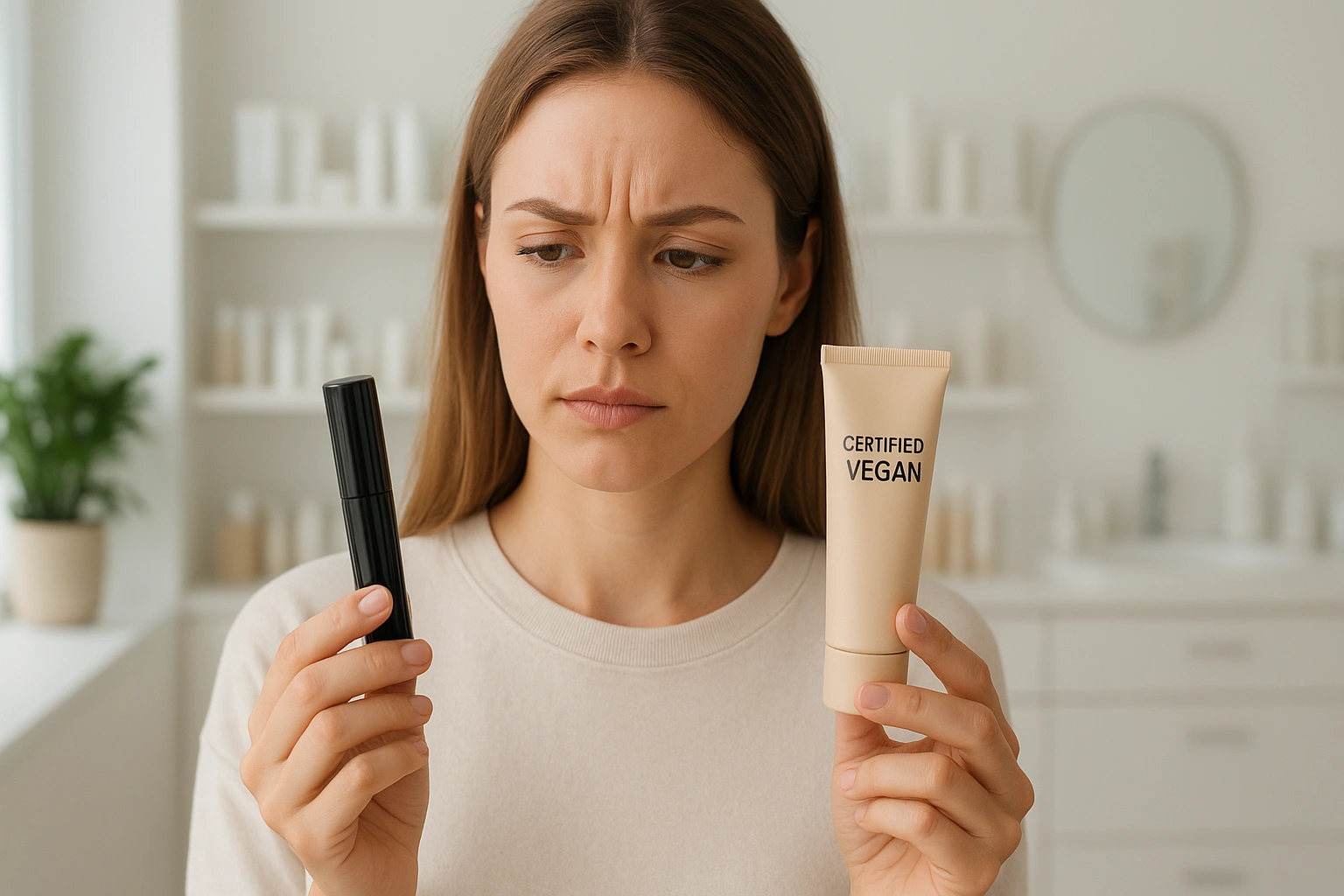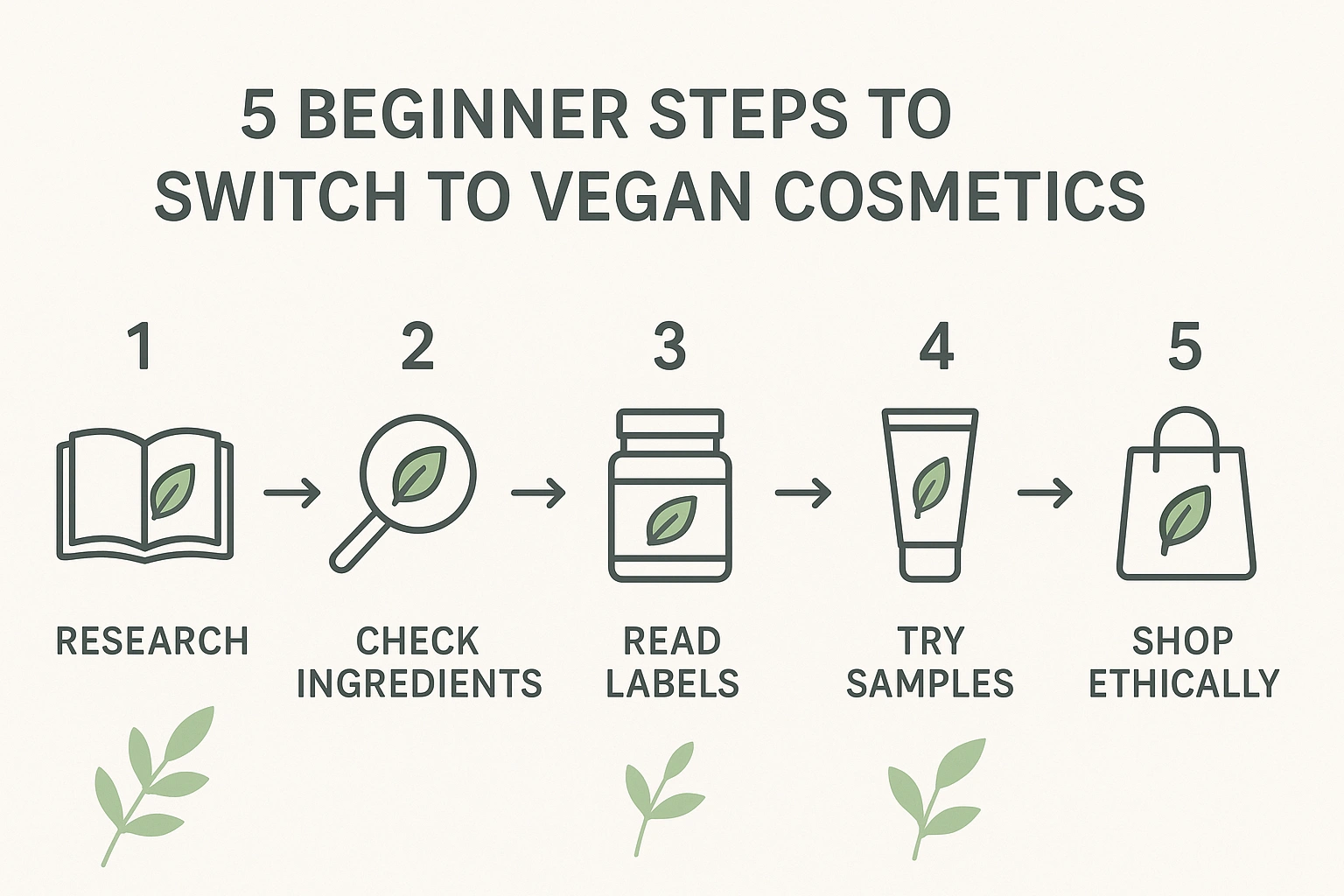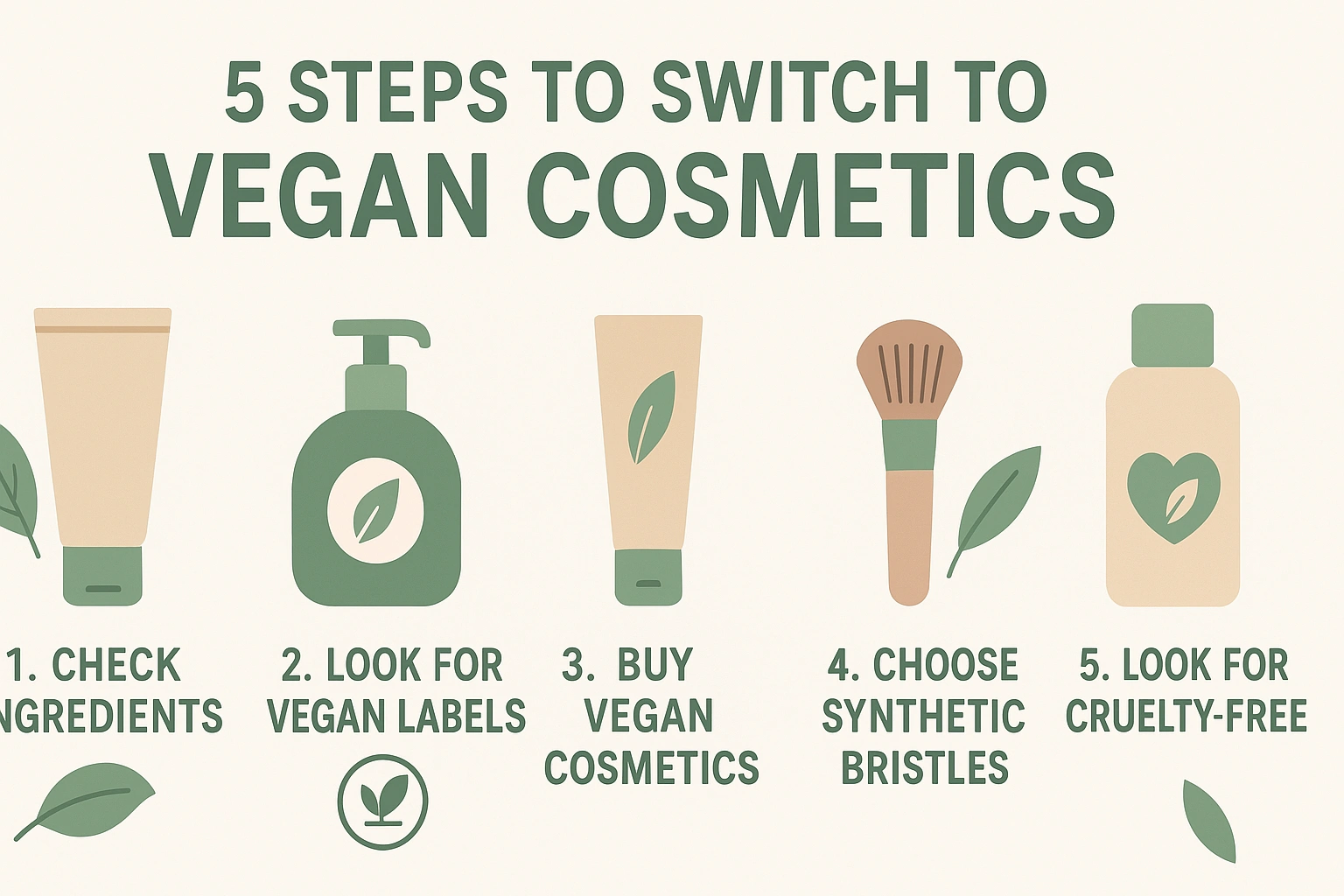You’ve seen the labels and heard the buzz, but the idea to switch to vegan cosmetics can feel overwhelming when you think about replacing everything at once.
Where do you even begin? The choice to switch to vegan cosmetics is one of the most powerful steps you can take for animals, the planet, and your skin.
Many people worry that to switch to vegan cosmetics means spending more or losing performance, but the process can actually be simple and rewarding.
This guide will show you how to switch to vegan cosmetics with clear steps and beginner vegan beauty tips, making the transition smooth, affordable, and exciting.
- What Does It Mean to Switch to Vegan Cosmetics?
- Why Making the Switch is a Beautiful Choice
- How to Switch to Vegan Cosmetics: A 5-Step Guide
- A Real-Life Switch: Finding My Holy Grail Vegan Mascara
- Comparison: Easy Vegan Swaps for Your Makeup Bag
- Common Mistakes to Avoid When Switching
- Expert Tips & Best Practices
- Frequently Asked Questions (FAQ)
- Conclusion
What Does It Mean to Switch to Vegan Cosmetics?
To switch to vegan cosmetics means making a conscious choice to buy and use makeup, skincare, and beauty tools that exclude all animal-derived ingredients.
When you switch to vegan cosmetics, you go beyond the idea of “cruelty-free,” since that label only ensures no animal testing but not the ingredients themselves.
The decision to switch to vegan cosmetics guarantees that everything—from pigments in lipstick to the bristles of brushes—comes from plant-based or safe synthetic sources.
By choosing to switch to vegan cosmetics, you align your beauty routine with values of compassion, sustainability, and skin-friendly care.
This isn’t just a niche movement anymore; it’s the future of the beauty industry. The global market for vegan cosmetics is booming, a trend that publications like Wired have covered as part of a larger shift towards ethical consumerism. In 2025, consumers demand performance, but they also demand compassion, and brands are listening.

Why Making the Switch is a Beautiful Choice
The decision to adopt a vegan beauty routine has a positive ripple effect that extends far beyond your makeup bag.
It’s a Stand Against Animal Cruelty
This is the most direct benefit. By choosing vegan, you ensure no animals were harmed or exploited for your products. This includes avoiding ingredients that require the harming of animals (like carmine) and supporting a market that is fundamentally kinder.
It Can Be Gentler on Your Skin
Vegan cosmetics often omit common animal-derived irritants like lanolin and beeswax, which can be pore-clogging for some. Instead, they utilize soothing and nourishing plant-based butters and oils, making them a fantastic option for sensitive and acne-prone skin types.
It’s a More Sustainable Option
Animal agriculture is a significant source of greenhouse gas emissions and deforestation. By reducing the demand for animal-derived ingredients, the vegan beauty industry helps to lessen this environmental burden. It’s a choice that aligns with a more sustainable future, a topic often explored in modern technological discussions.
How to Switch to Vegan Cosmetics: A 5-Step Guide
Ready to begin? Follow this simple, stress-free process to transition your beauty routine.

- Step 1: Don’t Purge Your Collection: The most sustainable and budget-friendly approach is to use up the products you already own. Don’t feel pressured to throw everything away and start from scratch.
- Step 2: Become a Label Detective: Start learning to read ingredient lists. Familiarize yourself with common non-vegan ingredients (see our table below!) and look for official vegan certification logos.
- Step 3: Identify Your Priorities: What product do you use up the fastest? Your daily foundation? Mascara? Plan to replace that item with a vegan alternative first.
- Step 4: Replace As You Go: This is the golden rule. When your favorite lipstick runs out, research and purchase a vegan replacement. This makes the process manageable and affordable.
- Step 5: Don’t Forget Your Tools: Many makeup brushes are made from animal hair (squirrel, goat, etc.). As you need to replace them, opt for high-quality synthetic brushes, which are now incredibly soft and effective.
A Real-Life Switch: Finding My Holy Grail Vegan Mascara
Mascara was the hardest product for me to part with. My favorite formula contained beeswax, which is what I thought gave it its staying power. I was convinced a vegan mascara would smudge and flake.
I did my research and found a highly-rated vegan mascara that used plant-based waxes instead. The first time I tried it, I was blown away. It gave me the same length and volume, held a curl all day, and didn’t smudge at all. It was proof that I didn’t have to sacrifice performance for my principles.
| Pros of Switching Mascara | Cons of Switching Mascara | |
|---|---|---|
| My Experience | Found a product with equal or better performance, peace of mind, discovered a new favorite brand. | Required initial research to find a good alternative. |
Comparison: Easy Vegan Swaps for Your Makeup Bag
| Conventional Product | Common Non-Vegan Ingredient | Easy Vegan Swap |
|---|---|---|
| Red Lipstick | Carmine (crushed beetles) | Lipsticks using fruit pigments or synthetic dyes. |
| Mascara & Eyeliners | Beeswax | Formulas with Candelilla or Carnauba wax. |
| Shimmery Eyeshadows | Guanine (fish scales) | Shadows using synthetic fluorphlogopite or mica. |
| Makeup Brushes | Animal Hair (goat, squirrel) | High-quality synthetic bristles (like Taklon). |
Common Mistakes to Avoid When Switching
- Assuming “Cruelty-Free” Means “Vegan”:** A cruelty-free product isn’t tested on animals, but it can still contain animal ingredients like honey or milk. Look for both labels.
- Falling for “Greenwashing”:** A brand might highlight one plant ingredient on the front, while hiding lanolin in the ingredient list. Trust certifications over marketing claims.
- Forgetting About Fragrance:** The term “fragrance” or “parfum” can legally hide animal-derived ingredients like musk. Look for brands that are transparent about their scent sources.
- Getting Overwhelmed:** Don’t try to learn every ingredient overnight. Start with the big ones (carmine, lanolin, beeswax) and expand your knowledge over time.
- Thinking It Has to Be All or Nothing:** Every single vegan choice you make is a positive step. Don’t let the quest for perfection stop you from starting.
Expert Tips & Best Practices
Make your transition even smoother with these pro tips.
- Use Technology: Apps like “Bunny Free” and “Leaping Bunny” allow you to scan barcodes to check a brand’s cruelty-free status.
- Start with Your Base: Your foundation, concealer, and powder are products you use daily. Making these your first vegan swaps will have the biggest impact.
- Explore Indie Brands: Many innovative, high-performance vegan brands are smaller, independent companies. Check out online beauty retailers that specialize in clean and vegan products.
- Follow Vegan Beauty Influencers: They do the hard work of testing and reviewing products, which can save you a lot of time and money.
“The best advice for anyone wanting to switch to vegan cosmetics is to be patient and curious. Treat it like a fun exploration. You’ll discover amazing new brands and products you would have never found otherwise. It’s a journey, not a destination.”
— Chloe Nguyen, Professional Makeup Artist
Frequently Asked Questions (FAQ)
Q: How do I know if a beauty product is truly vegan?
A: The most reliable method is to look for official third-party certifications from organizations like The Vegan Society or Vegan Action. If a product isn’t certified, you’ll need to carefully read the full ingredient list to check for animal-derived components.
Q: Is it expensive to switch to vegan cosmetics?
A: It doesn’t have to be! Many affordable drugstore brands now offer extensive vegan lines. The key is to replace products as you run out, rather than buying a whole new collection at once, which makes the transition very budget-friendly.
Q: Will vegan makeup perform as well as my current products?
A: Absolutely. The quality and performance of vegan makeup have improved dramatically. Brands now use high-performance plant waxes, butters, and pigments that offer the same longevity, color payoff, and texture as conventional cosmetics.
Q: What are some common hidden animal ingredients in makeup?
A: Be on the lookout for carmine (red pigment from beetles), guanine (from fish scales, for shimmer), lanolin (from wool), shellac (from insects), and beeswax. These are often found in lipsticks, eyeshadows, and mascaras.
Q: How long does it take to fully switch to vegan cosmetics?
A: The timeline is entirely up to you. A gradual approach, where you replace one item each time you run out, is the most sustainable and least overwhelming method. This could take anywhere from a few months to a year, depending on your collection.
Conclusion
To switch to vegan cosmetics is to align your beauty routine with compassion, sustainability, and mindful choices that reflect your values.
When you switch to vegan cosmetics gradually, you can transform your makeup collection without unnecessary stress or overspending.
The decision to switch to vegan cosmetics also means embracing beginner vegan beauty tips that support animals, the planet, and healthier skin.
By choosing to switch to vegan cosmetics, your beauty routine becomes not just self-expression but also a form of positive action.
For a searchable database of cruelty-free and vegan brands, visit the Leaping Bunny Program’s Shopping Guide.
